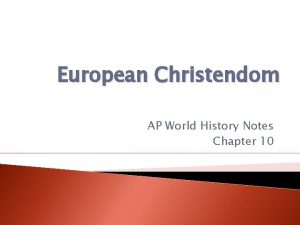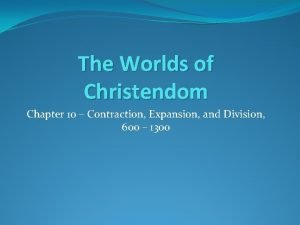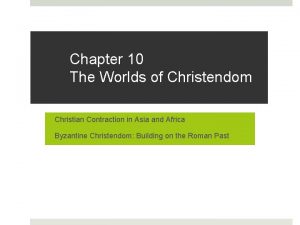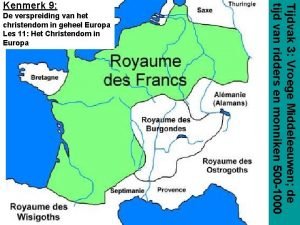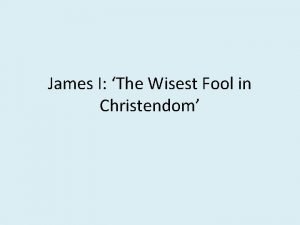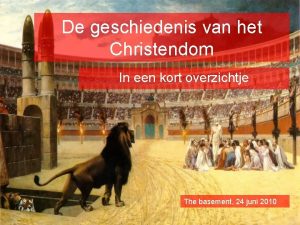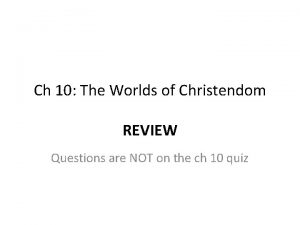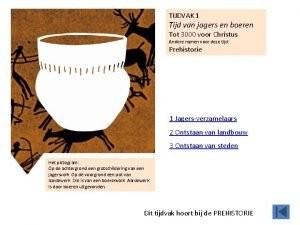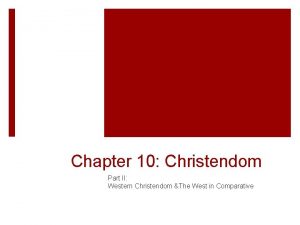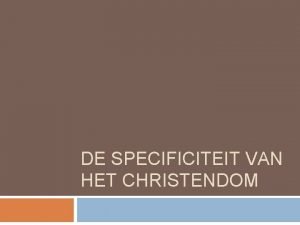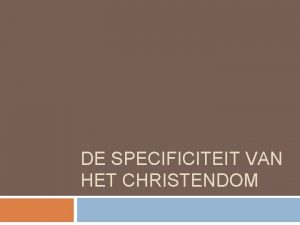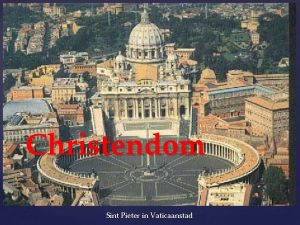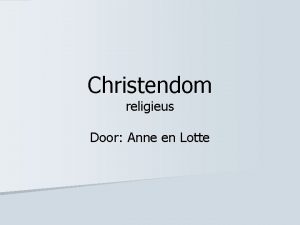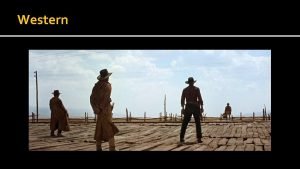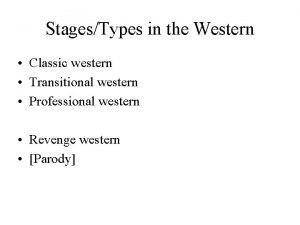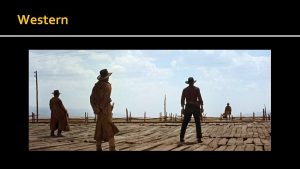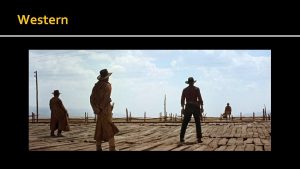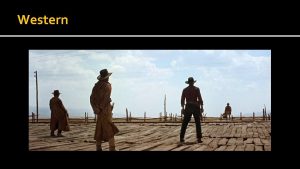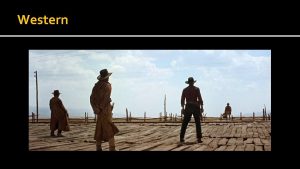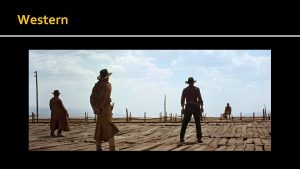Chapter 10 Christendom Part II Western Christendom The














- Slides: 14

Chapter 10: Christendom Part II: Western Christendom &The West in Comparative

Western Christendom: Rebuilding in the Wake of Roman Collapse ¡Class Discussion Questions: 1. What was lost with the fall of Rome? 2. What aspects of Rome survived?

Answers: ¡W/ the overthrow of the last Roman emperor in the west by the German general Odoacer, Rome officially fell. ¡Long term decline of central authority and civilization in the west. ¡ Central political authority collapsed, cities shrunk, literacy was lost, roads fell apart, trade broke down, barter replaced standard currency, disease ¡Mediterranean = fell apart; Northwest Europe = aspects survived ¡ Germanic people adopted Roman law and military organization

Germanic Kingdoms attempt to recreate Roman Style Unity ¡Charlemagne (768 -814 C. E. ) acted “imperial” ¡Revival of Roman Empire on Christmas Day 800 (coronation of Charlemagne); soon fragmented ¡Another revival of Roman Empire with imperial coronation of Otto I of Saxony (936 -973 C. E. ) would take title of Holy Roman Empire

Society and the Church ¡Within these new kingdoms: ¡ Highly fragmented, decentralized society ¡ Great local variation ¡ Landowning warrior elite exercised power ¡Social hierarchies ¡ Lesser lords and knights became vassals of kings or great lords ¡ Serfdom displaced slavery ¡Catholic Church was a major element of stability ¡ Hierarchy modeled on that of the Roman Empire ¡ Became very rich ¡ Conversion of Europe’s non-Christians (Capitulary of Saxony) ¡ Most of Europe was Christian (with pagan elements) by 1100

Society and the Church ¡Church and ruling class usually reinforced each other. ¡ Also elements of competition as rival center of powers ¡ Right to appoint bishops and the pope was controversial (the investiture conflict)

Accelerating Change in the West ¡Invasions in 700 -1000 C. E. hindered development ¡Weather improved ¡High Middle Ages = clear growth and expansion ¡Growth of long-distance trade ¡Town and city populations rose ¡Growth of territorial states with organized gov’ts ¡New Opportunity for women ¡New ideas about masculinity: warrior to “provider”


The Crusading Tradition ¡Medieval expansion of Christendom after 1000 C. E ¡ Same time as Byzantium declined ¡ Clearance of land, especially on eastern fringe of Europe ¡ Scandinavian colonies ¡ Europe had direct, though limited, contact w/ Asia (13 -14 th) ¡Crusading movement began in 1095 ¡ Wars at God’s command, authorized by the pope, for which participants received an indulgence ¡ Amazingly popular; were religious wars at their core

Crusades – regain Jerusalem ¡Many waves of crusaders to Near East ¡Creation of four small Christian states ¡Showed Europe’s growing organizational ability

Other Crusades ¡Iberian Peninsula Crusade ¡Baltic Crusade ¡Attacks on Byzantine Empire and Russia ¡Crusades had a significant impact on Europe: ¡ Conquest of Spain, Sicily, Baltic Region ¡ Crusaders weakened Byzantium ¡ Popes strengthened their position for a time ¡ Tens of thousands of Europeans made contact with the Islamic world ¡ Europeans developed taste for luxury goods of the East ¡ Muslim scholarship and Greek learning flowed into Europe ¡ Hardened cultural barriers between peoples

The West in Comparative Perspective ¡Catching Up ¡ Hybrid civilization of Western Europe was less developed ¡ Muslim viewed Europeans as barbarians ¡ Europeans were happy to exchange with/borrow from more advanced civilizations to the east ¡ Europe was a developing civilization ¡ By 1500 Europe had caught up and passed China and the Islamic world ¡ 500 – 1300 was a period of great innovation ¡ Agriculture, warfare

Pluralism in Politics ¡Europe crystalized into a system of competing states ¡Political pluralism shaped Western Europe civilization ¡ Wars and militarization ¡ Stimulated technological development ¡Rulers were generally weaker than those to the east ¡ King, nobles, the church struggled for power Merchants ¡ Development of representative institutions (parliaments)

Reason and Faith ¡Distinctive intellectual tension between faith and reason developed ¡Intellectual life flourished in the centuries after 1000 Universities ¡ Development of “natural philosophy” ¡Search for classical Greek texts ¡ Aristotle had deep impact, dominating European thought ¡No similar development occurred in the Byzantine Empire ¡ Suspicious of classical Greek thought ¡Islamic world had deep interaction with classical Greek thought ¡ Massive translation causing a flowering of Arab scholarship ¡ Islamic world eventually turned against natural philosophy
 Chapter 10 ap world history notes
Chapter 10 ap world history notes Chapter 10 the worlds of christendom notes
Chapter 10 the worlds of christendom notes The worlds of christendom
The worlds of christendom De verspreiding van het christendom in europa
De verspreiding van het christendom in europa The wisest fool in christendom
The wisest fool in christendom De geschiedenis van het christendom
De geschiedenis van het christendom In comparison to byzantium latin christendom
In comparison to byzantium latin christendom Islamische expansion tote
Islamische expansion tote Tijdvak jagers en boeren
Tijdvak jagers en boeren Hình ảnh bộ gõ cơ thể búng tay
Hình ảnh bộ gõ cơ thể búng tay Lp html
Lp html Bổ thể
Bổ thể Tỉ lệ cơ thể trẻ em
Tỉ lệ cơ thể trẻ em Gấu đi như thế nào
Gấu đi như thế nào Chụp phim tư thế worms-breton
Chụp phim tư thế worms-breton
